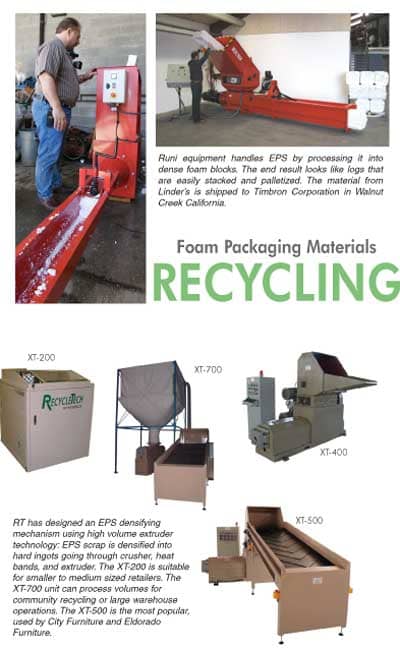Recycling EPS now makes sense for furniture retailers. There are a number of processing alternatives that can change its disposal from a big expense to one that can actually generate a payback. This article will provide highlights of several successful approaches. One will surely be viable for your company.

CASE STUDY: LINDER’S FURNITURE
Linder’s Furniture, the 2007 Western Home Furnishings Association Retailer of the Year, operates ten locations in Southern California. Operations Director Mark Kantor provided insight into a comprehensive program at Linder’s that resulted in the recycling of approximately 95% of all traditional waste products including office paper, corrugated, plastic film and EPS. Only garbage goes in the trash now.
Their on-site installation of Runi equipment provided by Olympic Wire & Equipment resulted in a payback in less than one year. It also resulted in favorable publicity in the local papers and positive employee attitudes regarding their roles in making the environment better.
Runi equipment handles EPS by processing it into dense foam blocks. The end result looks like logs that are easily stacked and palletized. The material from Linder’s is shipped to Timbron Corporation in Walnut Creek California to make interior trim moldings for Home Depot and other customers.
About twenty other locations have been set up with Runi equipment by Olympic Wire & Equipment in the West Coast region and there are numerous others throughout the USA and International locations.
OTHER EPS RECYCLING OPTIONS
If you are a smaller retailer for whom this capital expenditure on equipment doesn’t make sense, there may be other options. Check to see if there are community-wide recycling solutions for smaller generators in your area.The City of Roseville CA, for example, has been operating a community wide program for EPS since fall 2007. Materials can be dropped off at several recycling centers. The city provides containers for pick up from local furniture retailers generating larger amounts of EPS. Arrangements have been made for businesses to drop off EPS peanuts at package stores for reuse, and bubble wrap is recycled for use by local libraries to package inter library loans. Sam Bigley of the city’s Environmental Utilities department says that the response has been very positive and they are looking to expand their capacity.
Another approach to EPS recycling is to shred and extrude the foam material. This process removes air and produces ingots that can be molded into lamp bases, baseboards and similar items anywhere in the world. The ingots are fork lift handled in either large bags or boxes. City Furniture, Eldorado Furniture and many others are using RecycleTech equipment that uses this technology.
There are also numerous companies that can use packing foam for alternative uses. For instance, Rastra Inc. re-processes the foam for insulated concrete forms. This option may only be cost effective for you if you are within a reasonable distance from the secondary user of the material. After reviewing the cost of disposal versus transporting to a New Jersey foam recycler, Suburban Furniture’s Mark Friedman chose hauling to the recycling facility. They accumulate the foam in large plastic bags or mattress bags and deliver them in their own truck.
In conversations with retailers and delivery companies at the 2008 International Furniture Transportation & Logistics Conference, everyone concurred that proper separation of the various materials for recycling is essential. Foam glued to corrugated can’t be recycled. Retailers should ask their manufacturing suppliers, to work towards incorporating packaging details that maximize recycling opportunities.
Whether one system is better than another is beyond the scope of this article but users of each system were pleased with their respective results.
Any solution is obviously better than land filling EPS. Both Runi and RecycleTech offer equipment with capacities for small, medium and large generators of foam. The current value is in the range of 8 to 30 cents per pound depending on geographic location and market conditions.
Additional Information:
Alliance of Foam Packaging Recyclers: http://www.epspackaging.org/
Olympic Wire & Equipment Company : www.olympicequipment.com
Recycle Tech Corp: http://recycletechno.com
City of Roseville CA: www.roseville.ca.us/eu